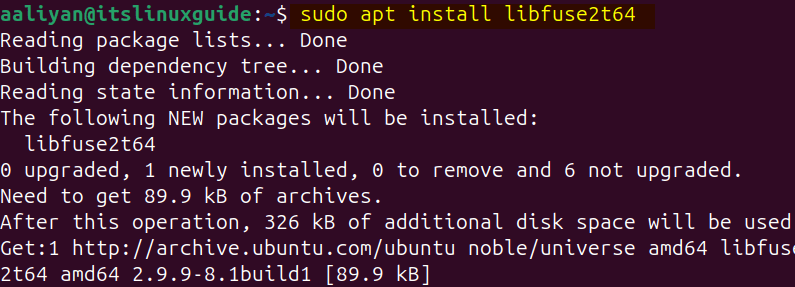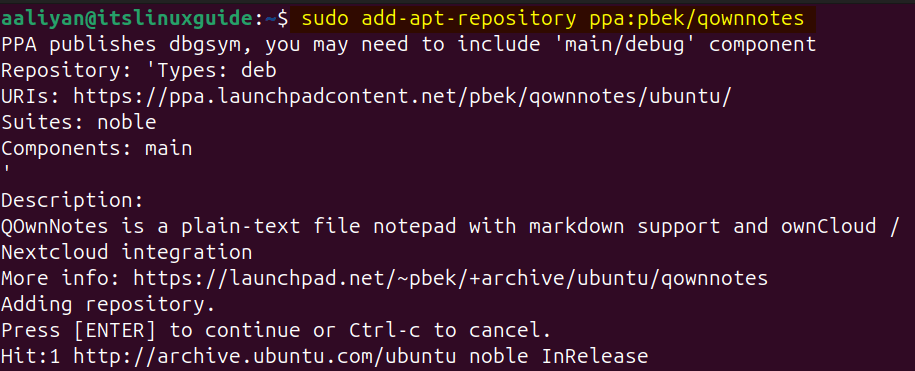QOwnNotes is an open-source application primarily used for creating markdown-based notes which are easy to write and read. Further, it can also be used to create plain text files as well, which can be beneficial if you want to open them on any other application. Moreover, there are several customization options that you can use for either managing the notes or personalizing the interface.
Note-taking can be beneficial whether you are attending any meeting or lecture. To install QOwnNotes on Ubuntu there are multiple ways like using Snap store or its AppImage file, this guide will explain all of them in detail.
6- Ways to Install QOwnNotes on Ubuntu
QOwnNotes also comes with a cloud feature that provides the privilege to its users, they share their notes with others having the same application. Further, you can also create to-do lists that can really help in tracking the progress of any project or task. Overall there are six ways to install QOwnNotes on Ubuntu and to illustrate them I will be using Ubuntu 24.04:
1: Through Snap Store
The first and one of the easy methods to install QOwnNotes on Ubuntu through the command line is using the Snap package installer. Use the below command to install QOwnNotes:
sudo snap install qownnotes
To verify the QOwnNotes installation via Snap you can either launch it from App menu or list down the Snap-installed apps on Ubuntu:
sudo snap list
2: Through the Ubuntu App Center
The next method using the Ubuntu App Center for QOwnNotes, this is the GUI method but uses the Snap Store for installation, The benefit of using this method other GUI is that you can also install the older version of it as well:

Once the installation is finished, you can either launch it from the apps menu or click on the Open button:

3: Through QOwnNotes Repository
Using a repository for app installation on Ubuntu can be a little risky as there are chances that it may get deprecated at any time. However, this method is feasible in cases when the apt package manager does not contain the application details. So to add the repository it is mandatory to validate it by GPG key so execute the below command to add its key:
SIGNED_BY='/etc/apt/keyrings/qownnotes.gpg'; sudo mkdir -p "$(dirname "${SIGNED_BY}")"; curl --silent --show-error --location http://download.opensuse.org/repositories/home:/pbek:/QOwnNotes/Debian_12/Release.key | gpg --dearmor | sudo tee "${SIGNED_BY}" > /dev/null; sudo chmod u=rw,go=r "${SIGNED_BY}"
Next, add the QOwnNotes repository in Ubuntu by saving it in apt sources list directory:
SIGNED_BY='/etc/apt/keyrings/qownnotes.gpg'; ARCHITECTURE="$(dpkg --print-architecture)"; echo "deb [arch=${ARCHITECTURE} signed-by=${SIGNED_BY}] http://download.opensuse.org/repositories/home:/pbek:/QOwnNotes/Debian_12/ /" | sudo tee /etc/apt/sources.list.d/qownnotes.list > /dev/null
Now refresh or update the packages list for apt :
sudo apt update
Next, install QOwnNotes on Ubuntu using the apt package manager:
sudo apt install qownnotes
To launch QOwnNotes on Ubuntu installed via its repository search for it in the Apps menu:

4: Through AppImage File
If you are looking for a pre-installed file of QOwnNotes on Ubuntu then you can download its AppImage file from GitHub QOwnNotes releases page:

Once the file is downloaded, simply change its execution permissions by using the chmod utility as in the command below:
sudo chmod u+x QOwnNotes-x86_64.AppImageOnce you execute the command the color of the file will turn green as in the image below:

Now execute this QOwnNotes AppImage file to launch it however you can face the error of missing fuse library:
sudo ./QOwnNotes-x86_64.AppImage
For that first, install the fuse library using the apt package manager:
sudo apt install libfuse2t64
Now again execute the AppImage file and the QOwnNotes will launch:

5: Through Flatpak App Installer
Another third-party app installer that can be used to install QOwnNotes on Ubuntu is the Flatpak package installer, to it install execute:
flatpak install flathub org.qownnotes.QOwnNotes
Now launch the QOwnNotes on Ubuntu installed via Flatpak by using the below command:
flatpak run org.qownnotes.QOwnNotes
6: Through PPA Repository
The sixth and last method to install QOwnNotes on Ubuntu is using the personal package archive where users and developers distribute software that isn’t available in the official repositories. So to add the PPA repository for QOwnNotes execute the below command:
sudo add-apt-repository ppa:pbek/qownnotes
After the PPA repository is added you need to update the packages list:
sudo apt update
Next, install QOwnNotes using its PPA repository by executing:
sudo apt-get-install qownnotes
To verify the QOwnNotes installation via PPA you can either launch it from App menu or list down the Snap-installed apps on Ubuntu:
sudo apt list --installed
Getting Started with QOwnNotes on Ubuntu
On the first launch of QOwnNotes on Ubuntu, there will be a configuration setup which include several steps. The first one is about allocating the directory for storage, here you can either link any pre-created one by clicking on Select folder option. On the other hand you can simply state path along with the folder name and it will be created automatically:

The next step will ask about the panel layout, here you can select the desired option based on your usage and afterwards click on Next to proceed:

If you have previously used QOwnNotes and now you are either shifting to a new or using another device then you can link it with your cloud to get all the notes save in the other device:

On the last step, you set your network settings which will be used to track the data usage and to keep track of any bugs encountered:

Now once the setup is finished QOwnNotes will open and on the top you will see a tool bar, from there you can create a new note, add date to the notes, load older notes, add links, add images, and much more:

How To Fix sudo: add-apt-repository: command not found on Ubuntu?
While installing QOwnNotes on Ubuntu via its PPA I encountered an error called add-apt-repository : command not found. The image below shows the following error:

This issue mainly occurs when the software-properties-common is missing so in that case you need to install it and for that use the following command:
sudo apt install software-properties-common
Now, when I add the PPA repository via add-apt-repository command you can see there is no error as in the image below:

Conclusion
This guide covered six ways to install QOwnNotes on Ubuntu, these include using Snap Store, Ubuntu App Center, QOwnNotes repository, AppImage file, Flatpak package installer, and PPA repository. Further the easy method to install it is using the AppImage file as it is it doest requires any installation methods. On the other hand use the Ubuntu App Center if you are looking for installation via GUI.
